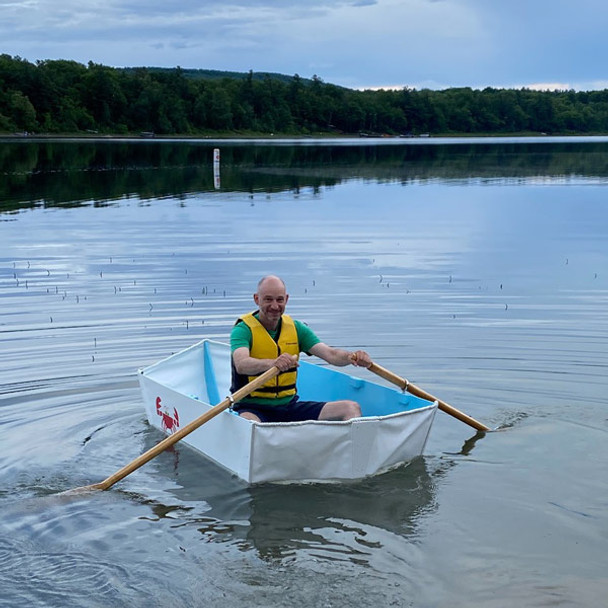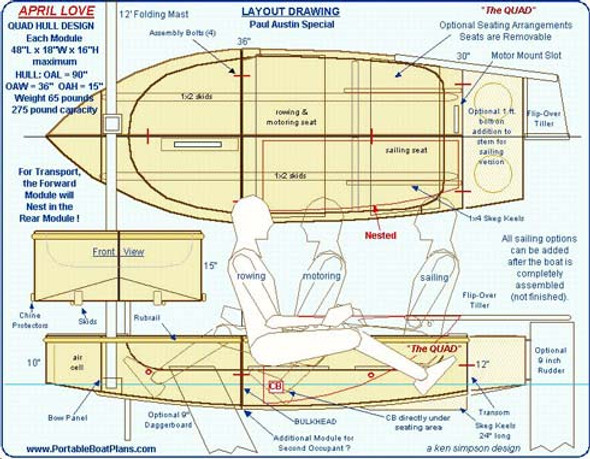Description
Origami 6
also see Origami 8
Folded: 6'2" (188cm) Long - 17" (43cm) Wide - 4" (10cm) High.
Assembled: 6'2" (188cm) Long - 3'2" (97cm) Wide - 14" (35cm) High.
Weight: From 15 kilos (33lbs)
Carrying capacity: Two adults or 150 kilos (330lbs)
Max outboard size: 3.3hp
Sail area: 2.5 sq metres (25 sq feet)
Origami is a small, easy to build and inexpensive folding dinghy. Don’t be fooled into thinking that a good folding dinghy needs to be complicated and expensive. Most often, simple is best. Origami is full of character, yet is surprisingly capable for such a tiny craft. Its square shape gives immense stability and good interior volume. It folds up and away in just a couple of minutes. Its light weight (about 26 pounds) means that it’s child’s play to launch and to retrieve. Even stowing is easy - just lay it on a bunk down below or lash it to the rails on deck.

Its fold down floors mean your weight is low down adding to its stability, yet far enough off the floor of the boat to ensure you never get a wet bottom. These same folding floors have built-in handles making Origami easy to move about when folded. When erected, the rowlock mountings double as handles. With or without an outboard, folded or not, Origami can be carried with ease.

With a 2hp outboard, speeds of up to 10 knots are possible. With a 3.3 hp speeds of up to 14 knots have been registered! This is not for the faint hearted however, but great fun never the less. Rowing is a pleasure, and there are two different places to mount the rowlocks depending on the number of occupants, so you can always be comfortable when rowing. At the rear on each side are skegs, giving origami very good directional stability. They also double as protectors when dragging the boat up the beach. Despite its light construction, Origami is an extremely tough little tender.

Origami is easy to make even if you have no experience. The comprehensive step by step instructions are backed up with photos that were taken during the actual construction of an Origami, a discussion of tools needed, and detailed instructions for marking out and cutting. The main ingredients are a sheet of ply, some PVC coated nylon cloth and some wood. You’ll also need a few basic tools such as a jigsaw, drill, plane and staple gun. The necessary materials are easy to come by, inexpensive and are available in varying degrees of quality to suit your budget.

Whether you want a super cheap dinghy or an extremely posh one, Origami will let you decide. In the instructions many different ways of building are examined. The proven way is shown but at each stage there are notes, such as choice of glues and pros and cons. Either way you can still build an Origami. For example, the use of stainless steel staples is recommended. One could use steel, but after a few years they will begin to rust and become unreliable. It's also a nice touch to trim the end grain of the plywood with solid wood, but this is time consuming and not strictly necessary though it does help to protect the vulnerable end grain from damage and looks so much better too.
See How simple it is to assemble
an Origami Folding Dinghy:
|
|
 Step Two: Pull out the other side panel. Step Two: Pull out the other side panel.
|
|
|
|
|
|
|
|
|
FAQ's
Q: How long will it take to build my Origami?
Much will depend on your skills and workspace. It is possible to have all the pieces marked and cut out in about 6 hours. Varnishing the dinghy could take the same again depending on how nicely you wanted to finish it. To actually assemble the dinghy once everything is varnished will take about 6 hours.
Q: How much will Origami cost to build?
Approximately $300, but this figure can go either way depending on the quality of the materials you choose to build your dinghy with.
Q: What is Origami's carrying capacity?
Two adults or approximately 350 pounds.
Q: How long does it take to assemble?
With practice Origami can be assembled, ready for launching in about one minute.
Q: Is there a sailing version?
Yes! Full instructions are now included for free with all our plans
Q: What is the biggest outboard I can fit?
Origami will take up to a 3.3hp engine.
Q: Yes, but how does it row?
Origami rows very nicely. The position of the rowlocks can be changed for rowing with two occupants
Q: How much does Origami weigh?
The 6' Origami weighs about 33 pounds (15 kilos) and can be carried folded or assembled with ease. The 8' model weighs 44 pounds (20 kilos).
Q: Can I personalise my dinghy?
Yes! The plans include many ideas for doing this, from changing the colour of the cloth to choosing a different wood.
Q: I don't have any experience, can I still build an Origami Folding Dinghy?
You do not need to have any experience building boats, you only need very basic woodworking skills, and a few tools such as a jigsaw and a plane.
Q: What are Origami's folded Dimensions?
6'2" (188cm) Long - 17" (43cm) Wide - 4" (10cm) High. (figures approximate)
Q: What are Origami's assembled Dimensions?
6'2" (188cm) Long - 3'2" (97cm) Wide - 14" (35cm) High. (figures approximate)
Additional Information
Measurements: |
Metric |
Designer Name: |
Benjy |
Sail area (Imperial / Metric): |
25 sq. ft / 2.32 sq. m |
Rig Type: |
Sprit |
Keel Type: |
Leeboards |
Rudder: |
Fixed |
Length (range): |
Under 8' / 2.44m |
LOA: |
6'2" / 1.88 m |
Length at Waterline: |
5'11" / 1.73 m |
Beam: |
3'2" / 0.97 m |
Hull Weight: |
Under 85 lbs / 38.56kg |
Estimated Hull Weight: |
33 lbs / 15 kilos |
Draft: |
Under 6" / 15.24cm |
Unloaded Draft: |
4" / 0.10 m |
Weight Capacity: |
330 lbs / 150 kilos |
Primary Material: |
Fabric Skin |
Method of Construction: |
Skin on Frame |
Hull: |
Monohull |
Hull Type: |
Displacement |
Hull Shape: |
Flat bottom |
Power Source: |
Electric, Human, Wind |
Motor: |
Outboard |
Horsepower Rating: |
3.3 hp |
Built-in Floatation: |
Optional |
Trailerable: |
Yes |
Cartop: |
Yes |
Unit of Measure: |
Metric |
Instruction Manual: |
Step-by-Step Instructions |
Lofting Required: |
No |
Recommended Experience Level: |
Beginner |
Designer's Thoughts on Experience Level: |
Our easiest build |
Boat Type: |
Sailboat |


 Step One:
Step One: Step Three:
Step Three: Step Four:
Step Four: Step Five:
Step Five: Step Six:
Step Six:



